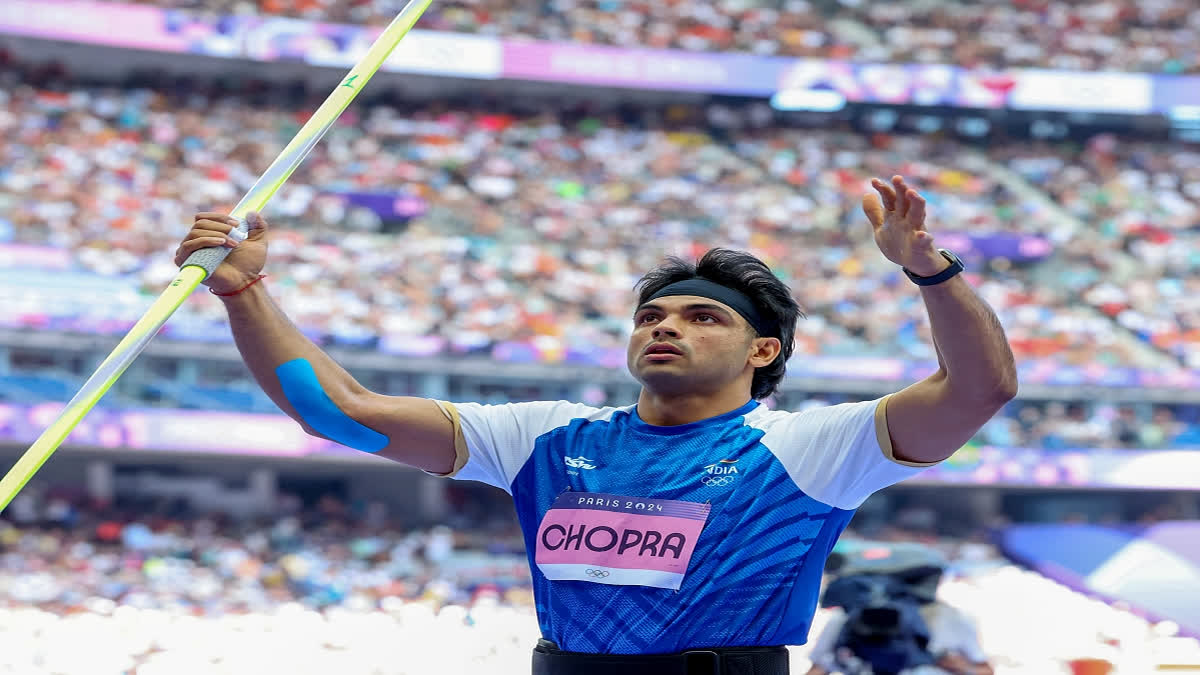Hyderabad: The National Javelin Throw Day will be celebrated across India on August 7, 2024. A glorious chapter in the history of Indian athletics was written on August 7.
The Athletics Federation of India (AFI), the country's governing body for athletics, unanimously decided to declare this day as National Javelin Throw Day. This momentous occasion is dedicated to honouring javelin thrower Neeraj Chopra, who bagged a gold medal in the 2020 Tokyo Olympics.
History of The Day: The genesis of National Javelin Day finds its roots in the extraordinary feat accomplished by Neeraj Chopra during the 2020 Tokyo Olympics. On August 7, Neeraj, who hails from Haryana, propelled a javelin through the air with incredible precision and power, covering a staggering distance of 87.58 meters. With this throw, Chopra secured the gold medal in the men’s Javelin Throw final, etching his name into the echelons of Indian sporting history.
Chopra's win was more than just a victory; it was a symbol of his unflinching dedication, relentless effort and unflinching spirit. He not only won the gold medal but also set a new record by winning India's first gold medal in track and field events at the Olympics.
In the year that followed, he won gold not once, but twice. Chopra's unwavering pursuit of perfection led him to win a silver medal at the World Athletics Championships in July 2022. His throw of 88.13m was not just a silver medal, but also a symbol of his perseverance and unwavering attitude.
Javelin Throw History: Long before the javelin throw became a global phenomenon following the athletic exploits of Uwe Hohn, Jan Zelezny, Tapio Rautavaara and more recently, Neeraj Chopra, Johannes Vetter and Anderson Peters, it was used by hunters and soldiers. Hunters used the skill of throwing a long stick with a spear at one end to kill animals while soldiers deployed it as a weapon in warfare. In modern times, the javelin throw helps win sporting honours.
Here’s How The Practice Of Hurling Spears Went From A Mode Of Warfare To An Olympic Sport
- Javelin throw made its first appearance as a sport in Greece at the Ancient Olympics in 708 BC. It was part of the pentathlon event along with running, discus throw, long jump and wrestling. The original javelin was made of olive wood.
- The condition of Olympia, the site of the Ancient Olympic Games, deteriorated after several battles and natural calamities hit the venue over the centuries. The Games officially ended around 394 AD after Roman emperor Theodosius I made pagan celebrations and functions illegal. This also put an end to the practice of flinging the javelin as a sport.
- Centuries later, it was the Scandinavians who revived the sport in the late 1700s.
- The Finns and the Swedes competed in two different disciplines of javelin throw – throwing at a target and throwing the farthest. However, in the following decades, throwing for distance became the more popular event.
The First Athlete To Dominate The Sport Of Javelin Throw: The first athlete to dominate the sport of javelin throw was Eric Lemming of Sweden. A versatile track and field athlete who specialised in throwing and jumping events, Lemming ruled the sport for more than a decade.
Javelin Throw Field: The field where javelin throw competitions are held can be divided into two parts - the runway and the landing sector.
Runway: The runway or take-off area is a stretch of running track which allows javelin throwers to make a running start before their throw and gather momentum before releasing the javelin. The runway should at least be 30 metres in length and can extend to 36.50 metres if conditions permit. The minimum width of a runway must be 4 metres. The end of the runway is marked by the throwing arc, which has an 8-metre radius. The throwing arc is also called the foul line or scratch line. Athletes cannot step beyond the runway markings once their attempt starts.
Landing Sector: In front of the runway, there’s a funnel-shaped landing sector, usually covered in grass or artificial turf. The lines of the funnel make an angle of 28.96 degrees when they meet after intersecting the two ends of the throwing arc at the end of the runway.
All About Neeraj Chopra:
The Olympic triumph was the culmination of a sporting journey that began when Chopra was just 13 years old. As an aspiring athlete, he used sports to overcome weight challenges and gain confidence. He was introduced to the javelin throw after watching the sport at the Shivaji Stadium in Panipat. Indian javelin thrower Jaiveer Choudhary recognised his potential and guided him to become a dominant force on the national and international stage.
Early Life: Neeraj Chopra is from Haryana. He was born in Khandra village in Panipat district. Khandra has a population of about 2,000, most of them farmers. Neeraj’s hometown is some 16 kms from the city of Panipat and 100 kms north of New Delhi. Neeraj Chopra’s father, Satish Kumar, is a farmer, while his mother, Saroj Devi, is a housewife. He also has two sisters. Neeraj had a pampered childhood.
Neeraj Chopra’s Achievements: Chopra became the under-16 national champion in javelin in 2012, and in the following years he won more medals at the national level. His first international medal was a silver at the Youth Olympic Games qualification competition in Bangkok in 2014. In 2016 Chopra won gold medals at the South Asian Games in Guwahati, Assam state; the Grand Prix in Lokeren, Belgium; and the IAAF (International Association of Athletics Federations) World U20 Championships in Bydgoszcz, Poland (the IAAF became known as World Athletics in 2019). His throw in the final in Bydgoszcz, 86.48 meters (283.73 feet), set an under-20 record. In 2017 Chopra placed first in the Asian Athletics Championships in Bhubaneshwar.



